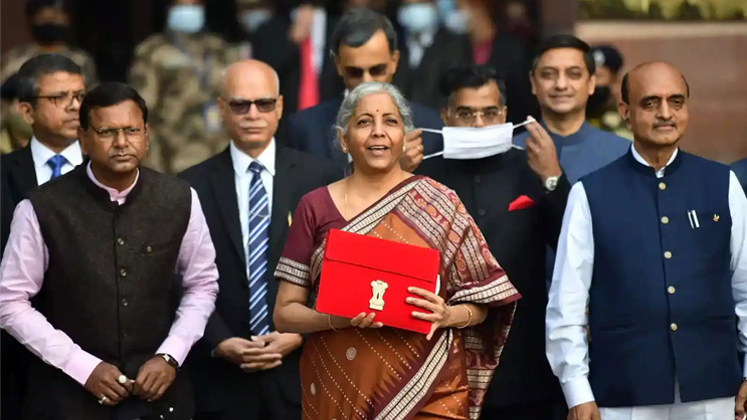Undoubtedly, the Budget – presented by Nirmala Sitharaman, Finance Minister, India – is a growth-oriented one with its focus revolving on heavy investment in infrastructure…This is believed to create opportunities for more investments in export sector and generate employment, while simplifying the procedures for the industries. Especially, the capital expenditure of the Central Government will be to the tune of Rs. 10.68 lakh crore for 2022-23 which is 4.1 per cent of the GDP and will help accelerate overall growth of the economy through investments amid disruptions due to intermittent lockdowns.
Now coming to textile and apparel industry, it can be derived from the budget speech that there is something for nearly every stakeholder of the textile value chain though some of the main demands of the industry such as the removal of 11 per cent import duty on cotton have not been addressed!
Specific announcement for the textile and apparel industry…
One of the biggest support to the apparel exporters in this Budget is the Guarantee cover under Export Credit Linked Guarantee Scheme (ECLGS) to be expanded by Rs. 50,000 crore to total cover of Rs. 5 lakh crore Credit Line till March 2023. This will be beneficial for the MSMEs.
Apparel exporters are seemingly delighted due to the reinstating of duty-free facility for importing embellishments like trimming, zipper, fasteners, buttons, lining material and packaging and this is expected to be a big boost for them. Notably, this was one of main demands the industry has been asking the Government to pay attention to since long.
The combination of specific and ad-valorem rate is being replaced by ad-valorem rates only and the rate for the items placed under tariff items of 6101, 6102 or 6103 (import of Men or Boys / Women or Girls Overcoats, Cloaks, Wind-Cheaters, Wind–Jackets and Women Jacket, Ensamples etc.,) has been increased from 10 per cent to 20 per cent and this will protect the domestic apparel business.
The extension of the benefit of 15 per cent tax for the newly incorporated manufacturing units by one more year to March 2024 will be instrumental in bringing in fresh investments. This would specifically help in bringing new investment in the new units under PLI scheme for MMF garments, MMF fabrics and technical textiles.
Skilling programmes and partnership with the industry will be reoriented to promote continuous skilling avenues, sustainability and employability. The National Skill Qualification Framework (NSQF) will be aligned with dynamic industry needs. Digital Ecosystem for Skilling and Livelihood – the DESH-Stack e-portal – will be launched. This aims to empower citizens to skill, reskill or upskill through online training.
The plan to enact a new Special Economic Zones (SEZ) Act will be helpful in creating employment, increasing exports and investments. Whilst exact details are not yet available but it should also assist the apparel sector since several units in the SEZs are from the apparel industry.
The Sovereign Green bonds for mobilising resources for green infrastructure will add value in reducing the carbon intensity of the economy.
Budget Estimates for Ministries 2022-2023 (INR Cr.)
| Ministries | Revenue | Capital | Total |
|---|---|---|---|
| Ministry of Textiles | 12357.11 | 25.03 | 12382.14 |
| Ministry of Skill Development and Entrepreneurship | 2847.54 | 151.46 | 2999 |
| Outlay on Major Schemes (INR Cr.) | FY-21 (Actual) | FY-22 (Estimates) | FY-22 (Revised Estimates) | FY-23 (Budget Estimates) |
|---|---|---|---|---|
| Procurement of Cotton by Cotton Corporation under Price Support Scheme | 663 | 136 | 8440 | 9243 |
| Amended Technology Upgradation Fund Scheme(ATUFS) | 556 | 700 | 650 | 650 |
| Central Silk Board | 650 | 875 | 875 | 875 |
Industry overly happy with the Budget
“It’s a growth-oriented budget. It has also taken care of our liquidity requirements by extending ECLGS. Most of the apparel exporters are in the MSME category and many are still struggling with the impact of disruptions caused by COVID-19 pandemic. Trimmings and embellishments like fasteners, inlay cards, linings and interlinings, laces, etc., that are used for branding and are nominated by the buyers were allowed duty-free earlier. The resumption of the facility will help apparel exporters make their products more internationally competitive. This is a big relief for small exporters,” shared Narendra Goenka, Chairman, Apparel Export Promotion Council (AEPC).
“For ATUFs, the allocated amount in the Budget is Rs. 650 crore as like last year and the increased allocation is needed to clear the pending claims, and as the new scheme Textiles Technology Development Scheme is replacing ATUFs with Capital Subsidy of 25 per cent, against 15 per cent in ATUFs, the requirement of amount is more. I laud for the announcement on popularisation of One Station One Product concept and in due course of time, the transportation of domestic garments from Tirupur will increase through Rail transportation to reach the various destinations,” commented Raja M Shanmugham, President, Tirupur Exporters’ Association (TEA)
“The extension of the ECLG Scheme for MSMEs for one more year should also help the apparel industry. However, it is unfortunate that the enhanced outlay for the scheme is restricted only for the hospitality industry – as the retail industry was as badly impacted in the pandemic hospitality. Even under the current wave, retail continues to be impacted with lockdowns, partial closures, limited working hours, etc.,” Rahul Mehta, Chief Mentor, Clothing Manufacturers Association of India (CMAI)
“The budget allocation for the textile sector stated for the year FY ’23 stands at about Rs.12,382.14 crore which is about 8.1 per cent higher than the revised budget allocation of FY ’22 which stood at about Rs.11,449.32 crore. The Government has allocated about Rs.133.83 crore for ‘Textile Cluster Development Scheme’; hence the total budget allocation for ‘Research and Capacity Building’ for textiles has increased by 73.4 per cent to reach about Rs.478.83 crore in FY ’23 as compared to the revised budget allocation of Rs.276.10 crore in FY ’22,” T. Rajkumar, Chairman, Confederation of Indian Textile Industry (CITI)
“It is a future-centric budget. E-passports with chips are a good introduction, besides security may reduce renewing time for exporters like us. We hope this also extends to technology enhancement and the introduction of AI in textile mills and Made-ups space. We were very hopeful about the Government helping bring down cotton prices. That we didn’t see yet,” Vanduta Khurana, MD, Daks India Industries and CII Textiles Committee
“It is heartening to note that the country is expected to grow at 9.27 per cent in the coming year, a phenomenal achievement for any country in the post-Covid period. Considering the phenomenal growth of the industry and achieving the vision of doubling the textile business size in the next five years, it is essential for the Government to allocate necessary funds and announce Technology Mission on Cotton 2.0 on a war footing. ,” Ravi Sam, Chairman, The Southern India Mills’ Association (SIMA)
“The initiation of Ease of Doing Business 2.0 with industry stakeholders consultation is a much-needed one to improve our ranking. Similarly extension of one year period for tax incentives for new manufacturing units will motivate industries regarding new Capex. Using technology for crop assessment if attempted for cotton in a top priority, it will be helpful for the industry to get good market intelligence,” informed Prabhu Dhamodharan, Convenor, Indian Texpreneurs Federation (ITF), Coimbatore
“PM GatiShakti is a transformative approach for economic growth and sustainable development. The approach, driven by seven engines, namely, Roads, Railways, Airports, Ports, Mass Transport, Waterways, and Logistics Infrastructure will pull forward the economy in unison,” Rakesh Kumar, DG, Export Promotion Council for Handicraft (EPCH)
“The budget puts immense thrust in manufacturing and capital expenditure which should enable the economy to grow and achieve its target of being a US $ 5 trillion economy by 2025. The positive initiative taken towards green power and the allocation of Rs. 19,500 crore for manufacturing of additional solar panels to meet the requirement of solar power in multiple sectors is noteworthy,”averred Dr. S N Modani, CEO & MD, Sangam India Ltd.
“The Finance Minister presented a positive and growth-oriented budget which was overall on expected lines. No major tinkering has been done and major impetus has been given to the start-ups and reduction in taxation on digital assets is also a step in the right direction. The budget has tried to encompass all segments of the society with a focus on rural housing, MSP direct payments and Rs.2 trillion outlay for MSME,” mentioned Nivedan Churiwal, MD, BSL Ltd.
“The Government has reposed its faith in taxpayers, entrepreneurs, investors, enabling it to build an open, digital and inclusive India with a 25-year vision. As there has been no reduction/relief on the personal taxation side, however, the good part is that we did not see levy of any additional tax.,” Vinod Kumar Gupta, MD – Dollar Industries Limited
“We welcome the Government’s decision of implementing the initiatives under the GatiShakti scheme which will help in enhancing logistical connectivity across the country through multimodal logistics parks which will help in the movement of goods more efficiently,” stated Prashant Agarwal, MD, BRFL Textiles, adding, “Special Economic Zones such as large textiles clusters, will play a significant role in the growth of the Indian textile industry, especially for exports.”
“Removal of exemptions on customs levy on certain chemicals and textiles that can be manufactured in India and provision of concessional duties on raw material that are used in manufacturing of intermediate products will boost the objective of Make in India and Atmanirbhar Bharat,” Rahul Tikoo, MD, India Sub Continent, Huntsman International (India)







